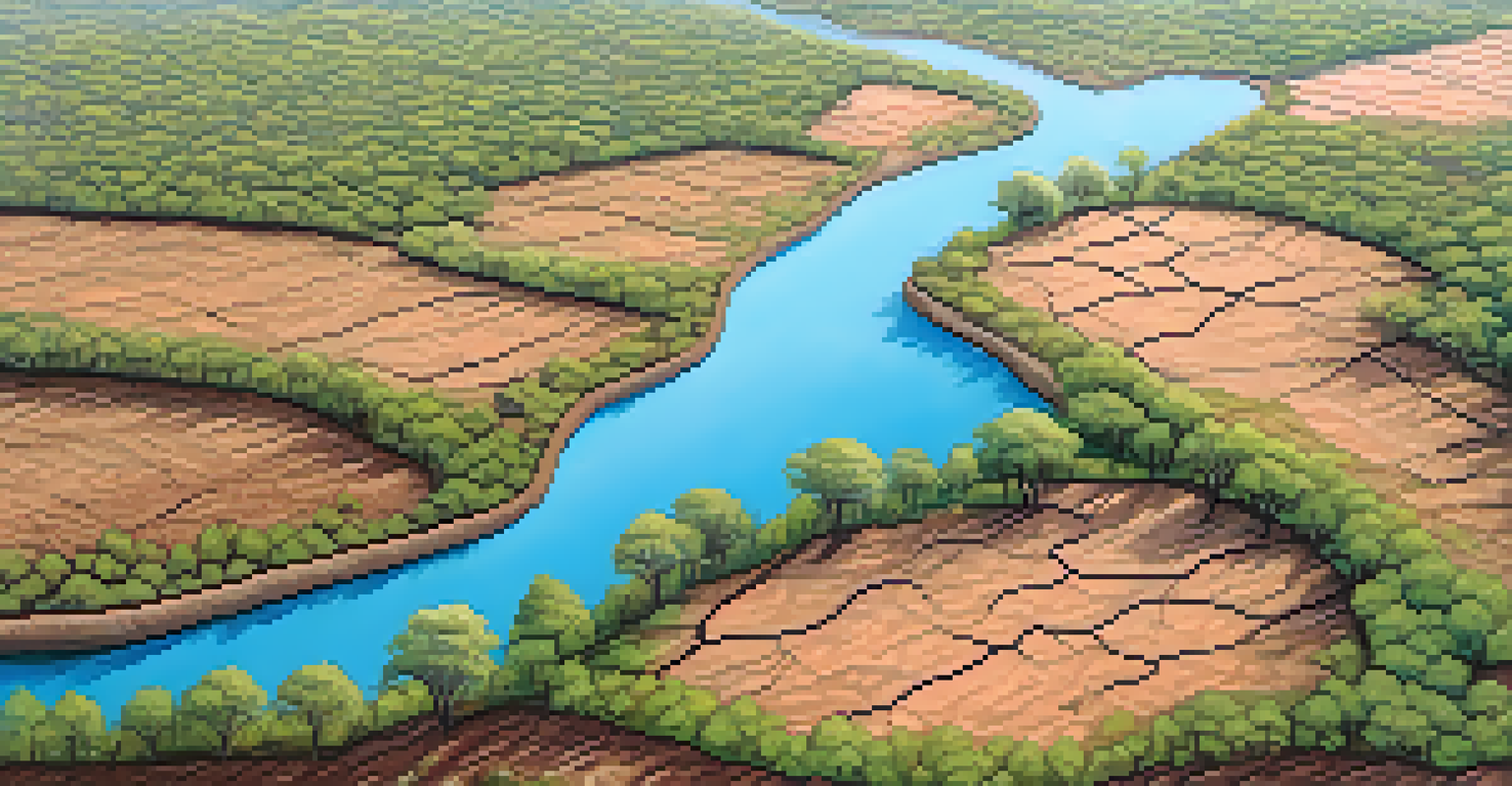Effects of Deforestation on Ecosystem Health and Plant Life

Defining Deforestation and Its Causes
Deforestation refers to the large-scale removal of trees from forested areas, often resulting in land conversion for agriculture, urban development, or logging. This practice has seen a dramatic increase in recent years, driven by the growing demand for timber, paper, and land for livestock and crops. Additionally, infrastructure projects and mining activities contribute significantly to forest loss, highlighting a complex web of contributing factors.
The clearest way into the Universe is through a forest wilderness.
The consequences of deforestation extend beyond just the loss of trees; they disrupt entire ecosystems. For instance, when forests are cleared, the delicate balance of flora and fauna is thrown into disarray. The resultant habitat loss can lead to the decline of various species that depend on these environments for survival.
Understanding the causes of deforestation is essential for addressing its effects. By identifying the drivers—such as agriculture and urbanization—we can begin to implement strategies aimed at sustainable land use and conservation efforts that protect our remaining forests.
Impact on Biodiversity and Wildlife
Biodiversity refers to the variety of life in a particular habitat, and forests are some of the richest ecosystems on our planet. Deforestation poses a direct threat to this biodiversity, as many species lose their homes and sources of food. This loss can lead to extinction for some species, particularly those that are already vulnerable or endemic to specific forest areas.

For example, the destruction of tropical rainforests in the Amazon has resulted in the loss of countless species, some of which are still undiscovered. The interdependence of species means that the extinction of one can have a cascading effect on others, further destabilizing the ecosystem. This domino effect can lead to reduced genetic diversity, making ecosystems less resilient to changes.
Deforestation Harms Biodiversity
The large-scale removal of trees disrupts ecosystems, leading to habitat loss and potential extinction of various species.
Moreover, as habitats shrink, wildlife is forced to adapt, migrate, or face extinction. These changes can lead to increased human-wildlife conflict, as animals venture into human settlements in search of food and shelter. This scenario underscores the urgent need to protect biodiversity and find solutions that balance human needs with ecological health.
Effects on Soil Quality and Erosion
Trees play a vital role in maintaining soil health by preventing erosion, enhancing fertility, and retaining moisture. When forests are cleared, the protective cover provided by trees is lost, exposing the soil to the elements. This exposure can lead to significant soil erosion, washing away nutrient-rich topsoil and degrading the land's agricultural potential.
In every walk with nature one receives far more than he seeks.
Additionally, deforestation can alter the soil's structure, leading to compaction and reduced permeability. As a result, rainwater struggles to penetrate the ground, increasing runoff and the risk of flooding. This not only affects local ecosystems but also disrupts agricultural practices, threatening food security in the region.
To combat soil degradation, it's essential to implement sustainable land management practices. Reforestation and agroforestry can help restore soil health and prevent erosion, ensuring that both ecosystems and agriculture can thrive side by side.
Alteration of Water Cycles
Forests play a critical role in regulating water cycles by facilitating precipitation and maintaining groundwater levels. Trees absorb and release water through a process called transpiration, which contributes to cloud formation and rainfall. When forests are removed, this natural cycle is disrupted, leading to changes in local and regional weather patterns.
For instance, areas that once experienced consistent rainfall may face drought conditions as fewer trees mean less moisture in the atmosphere. Conversely, the loss of tree cover can lead to increased flooding, as the soil's ability to absorb water diminishes. This alteration of water cycles can have severe implications for both ecosystems and human communities reliant on consistent water supplies.
Soil and Water Cycles Disrupted
Clearing forests results in soil erosion and alters water cycles, negatively impacting agriculture and local climates.
To mitigate these impacts, it’s crucial to consider sustainable land practices that protect existing forests and promote reforestation efforts. By restoring tree cover, we can help stabilize local climates and ensure that water cycles function more effectively.
Climate Change and Carbon Emissions
Forests act as carbon sinks, meaning they absorb carbon dioxide (CO2) from the atmosphere. Deforestation, on the other hand, releases that stored carbon back into the atmosphere, contributing to climate change. This process not only accelerates global warming but also disrupts the balance of greenhouse gases, leading to more extreme weather patterns and environmental challenges.
The relationship between deforestation and climate change is a vicious cycle: as global temperatures rise, forests become more susceptible to pests, diseases, and fires, which in turn leads to further deforestation. For instance, the increased frequency of wildfires in forested areas can devastate entire ecosystems, releasing vast amounts of CO2 and exacerbating climate issues.
To combat these challenges, it’s essential to advocate for policies that promote forest conservation and reforestation. By reducing deforestation and restoring tree cover, we can help mitigate climate change while also preserving vital ecosystems.
Cultural and Economic Consequences
Forests are not only vital for ecological health but also hold cultural significance for many communities around the world. Indigenous peoples and local communities often rely on forests for their livelihoods, traditions, and cultural practices. Deforestation can disrupt these connections, leading to loss of identity and cultural heritage.
Economically, forests provide resources such as timber, fuel, and non-timber forest products, which are essential for many local economies. However, unsustainable logging practices can deplete these resources, leading to economic instability. In contrast, sustainable forest management can offer long-term economic benefits while preserving cultural and ecological integrity.
Cultural and Economic Impacts
Deforestation affects local communities by threatening their livelihoods and cultural practices while undermining economic stability.
Finding a balance between economic development and environmental conservation is crucial. Encouraging sustainable practices and respecting the rights of local communities can lead to more equitable outcomes for both people and ecosystems.
Restoration and Conservation Efforts
Restoration and conservation are key strategies in addressing the effects of deforestation. Initiatives such as reforestation, afforestation, and sustainable land management aim to restore degraded ecosystems and enhance biodiversity. These efforts not only benefit wildlife but also help to mitigate climate change and improve soil and water quality.
For example, community-led reforestation projects have proven successful in restoring native forests while providing local jobs and resources. These initiatives empower communities to take an active role in protecting their environment, fostering a sense of stewardship and responsibility.

Conservation efforts also involve protecting existing forests from illegal logging and unsustainable practices. By promoting awareness and enforcing regulations, we can ensure that forest ecosystems are preserved for future generations, highlighting the importance of collaboration between governments, organizations, and local communities.